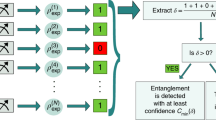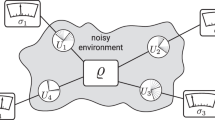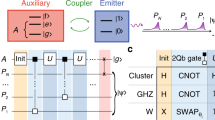Abstract
Entanglement is considered to be one of the most important resources in quantum information processing schemes, including teleportation1,2,3, dense coding4 and entanglement-based quantum key distribution5. Because entanglement cannot be generated by classical communication between distant parties, distribution of entangled particles between them is necessary. During the distribution process, entanglement between the particles is degraded by the decoherence and dissipation processes that result from unavoidable coupling with the environment. Entanglement distillation and concentration schemes6,7,8,9 are therefore needed to extract pairs with a higher degree of entanglement from these less-entangled pairs; this is accomplished using local operations and classical communication. Here we report an experimental demonstration of extraction of a polarization-entangled photon pair from two decohered photon pairs. Two polarization-entangled photon pairs are generated by spontaneous parametric down-conversion and then distributed through a channel that induces identical phase fluctuations to both pairs; this ensures that no entanglement is available as long as each pair is manipulated individually. Then, through collective local operations and classical communication we extract from the two decohered pairs a photon pair that is observed to be polarization-entangled.
This is a preview of subscription content, access via your institution
Access options
Subscribe to this journal
Receive 51 print issues and online access
$199.00 per year
only $3.90 per issue
Buy this article
- Purchase on Springer Link
- Instant access to full article PDF
Prices may be subject to local taxes which are calculated during checkout




Similar content being viewed by others
References
Bennett, C. H. et al. Teleporting an unknown quantum state via dual classical and Einstein-Podolsky-Rosen channels. Phys. Rev. Lett. 70, 1895–1898 (1993)
Bouwmeester, D. et al. Experimental quantum teleportation. Nature 390, 575–579 (1997)
Furusawa, A. et al. Unconditional quantum teleportation. Science 282, 706–709 (1998)
Bennett, C. H. & Wiesner, S. J. Communication via one- and two-particle operators on Einstein-Podolsky-Rosen states. Phys. Rev. Lett. 69, 2881–2884 (1992)
Ekert, A. K. Quantum cryptography based on Bell's theorem. Phys. Rev. Lett. 67, 661–663 (1991)
Bennett, C. H., Bernstein, H. J., Popescu, S. & Schumacher, B. Concentrating partial entanglement by local operations. Phys. Rev. A 53, 2046–2052 (1996)
Bennett, C. H., DiVincenzo, D. P., Smolin, J. A. & Wootters, W. K. Mixed-state entanglement and quantum error correction. Phys. Rev. A 54, 3824–3851 (1996)
Bennett, C. H. et al. Purification of noisy entanglement and faithful teleportation via noisy channels. Phys. Rev. Lett. 76, 722–725 (1996)
Deutsch, D. et al. Quantum privacy amplification and the security of quantum cryptography over noisy channels. Phys. Rev. Lett. 77, 2818–2821 (1996)
Bose, S., Vedral, V. & Knight, P. L. Purification via entanglement swapping and conserved entanglement. Phys. Rev. A 60, 194–197 (1999)
Pan, J.-W., Simon, C., Brukner, C. & Zeilinger, A. Entanglement purification for quantum communication. Nature 410, 1067–1070 (2001)
Yamamoto, T., Koashi, M. & Imoto, N. Concentration and purification scheme for two partially entangled photon pairs. Phys. Rev. A 64, 012304 (2001)
Zhao, Z., Pan, J.-W. & Zhan, M. S. Practical scheme for entanglement concentration. Phys. Rev. A 64, 014301 (2001)
Kwiat, P. G., Barraza-Lopez, S., Stefanov, A. & Gisin, N. Experimental entanglement distillation and ‘hidden’ non-locality. Nature 409, 1014–1017 (2001)
Kwiat, P. G. et al. Ultrabright source of polarization-entangled photons. Phys. Rev. A 60, R773–R776 (1999)
Kim, Y. H., Kulik, S. P. & Shih, Y. High-intensity pulsed source of space-time and polarization double-entangled photon pairs. Phys. Rev. A 62, 011802 (2000)
James, D. F. V., Kwiat, P. G., Munro, W. J. & White, A. G. Measurement of qubits. Phys. Rev. A 64, 052312 (2001)
Bouwmeester, D. et al. Observation of three-photon Greenberger-Horne-Zeilinger entanglement. Phys. Rev. Lett. 82, 1345–1349 (1999)
Pan, J.-W. et al. Experimental demonstration of four-photon entanglement and high-fidelity teleportation. Phys. Rev. Lett. 86, 4435–4438 (2001)
Jennewein, T., Weihs, G., Pan, J.-W. & Zeilinger, A. Experimental nonlocality proof of quantum teleportation and entanglement swapping. Phys. Rev. Lett. 88, 017903 (2002)
Lamas-Linares, A., Howell, J. C. & Bouwmeester, D. Stimulated emission of polarization-entangled photons. Nature 412, 887–890 (2001)
Zukowski, M., Zeilinger, A. & Weinfurter, H. Entangling photons radiated by independent pulsed sources. Ann. NY Acad. Sci. 755, 91–102 (1995)
Rarity, J. G. Interference of single photons from separate sources. Ann. NY Acad. Sci. 755, 624–631 (1995)
Özdemir, Ş. K., Miranowicz, A., Koashi, M. & Imoto, N. Pulse mode projection synthesis: Effects of mode mismatch on optical state truncation and preparation. Phys. Rev. A 66, 053809 (2002)
Nagata, K., Koashi, M. & Imoto, N. Observables suitable for restricting the fidelity to multipartite maximally entangled states. Phys. Rev. A 65, 042314 (2002)
Pittman, T. B., Jacobs, B. C. & Franson, J. D. Probabilistic quantum logic operations using polarizing beam splitters. Phys. Rev. A 64, 062311 (2001)
Pittman, T. B., Jacobs, B. C. & Franson, J. D. Demonstration of nondeterministic quantum logic operations using linear optical elements. Phys. Rev. Lett. 88, 257902 (2002)
Pan, J.-W. & Zeilinger, A. Greenberger-Horne-Zeilinger-state analyzer. Phys. Rev. A 57, 2208–2211 (1998)
Knill, E., Laflamme, R. & Milburn, G. J. A scheme for efficient quantum computation with linear optics. Nature 409, 46–52 (2001)
Koashi, M., Yamamoto, T. & Imoto, N. Probabilistic manipulation of entangled photons. Phys. Rev. A 63, 030301 (2001)
Acknowledgements
We thank K. Nagata, K. Tamaki, A. Miranowicz and J. Shimamura for helpful discussions.
Author information
Authors and Affiliations
Corresponding author
Ethics declarations
Competing interests
The authors declare that they have no competing financial interests.
Rights and permissions
About this article
Cite this article
Yamamoto, T., Koashi, M., Özdemir, Ş. et al. Experimental extraction of an entangled photon pair from two identically decohered pairs. Nature 421, 343–346 (2003). https://doi.org/10.1038/nature01358
Received:
Accepted:
Issue Date:
DOI: https://doi.org/10.1038/nature01358
This article is cited by
-
A photonic entanglement filter with Rydberg atoms
Nature Photonics (2023)
-
Optimal tripartite quantum teleportation protocol through noisy channels
Quantum Information Processing (2023)
-
Faithful quantum entanglement purification and concentration using heralded high-fidelity parity-check detectors based on quantum-dot-microcavity systems
Quantum Information Processing (2022)
-
Optimal teleportation via noisy quantum channels without additional qubit resources
npj Quantum Information (2021)
-
Quantum circuit optimization using quantum Karnaugh map
Scientific Reports (2020)
Comments
By submitting a comment you agree to abide by our Terms and Community Guidelines. If you find something abusive or that does not comply with our terms or guidelines please flag it as inappropriate.



